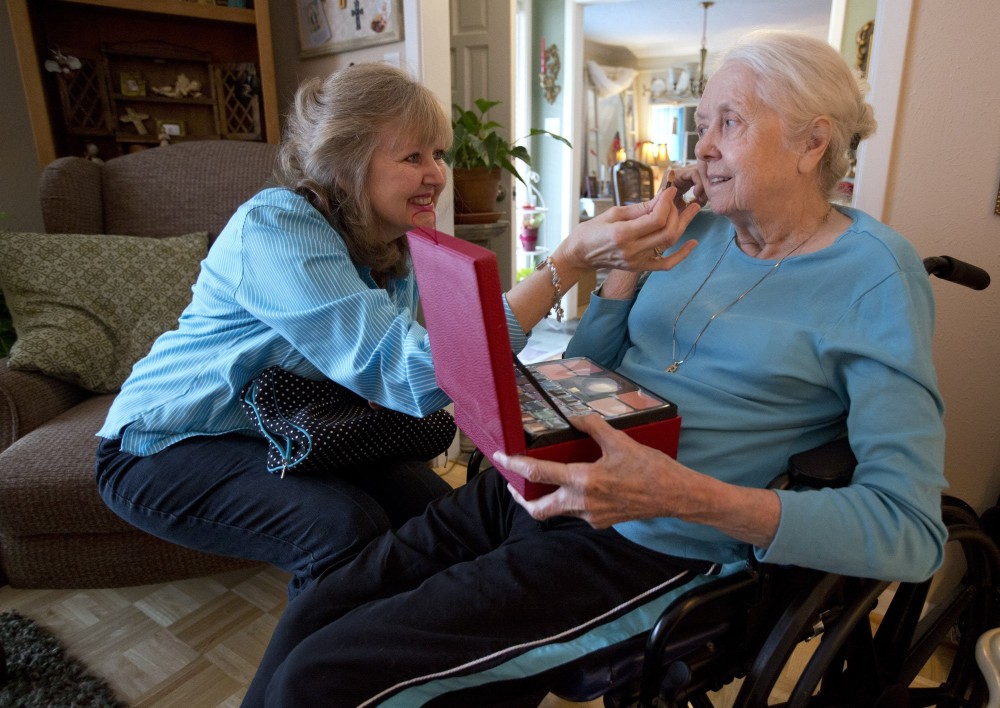By Amanda Cuda
Connecticut Post, Bridgeport.
Amy Kahn Russell wasn’t always her family’s primary breadwinner. The 58-year-old Ridgefield resident also used to leave a lot of the household bills to her husband, Scott.
But her life has changed significantly since Scott was diagnosed with Alzheimer’s disease about six years ago, when he was in his late 50s.
Alzheimer’s is a form of dementia that interferes with memory, thinking and behavior to the point where many of the people afflicted need assistance with even the most basic activities.
Scott’s Alzheimer’s hasn’t progressed to that point yet. He still drives and can sometimes still handle the bills. But as the years and his illness progress, his wife finds herself taking on more responsibilities.
For example, she handles more of the household finances than previously. In addition, her jewelry design business is the family’s main source of income, as her husband had to leave his job several years ago due to the Alzheimer’s.
Amy Russell also has to take care of her husband. Though his needs are less than those of many other Alzheimer’s patients, she still has to manage his medications and provide other care.
“Different caregivers have different levels, as far as what they have to do,” she said. “But it’s still a full-time job.”
She’s one of many women nationwide taking on that job. The 2014 Alzheimer’s Disease Facts and Figures report, released Wednesday, shows that women represent between 60 and 70 percent of the 15 million Americans providing unpaid care for someone with Alzheimer’s disease.
The report also shows that roughly two-thirds of the 5 million Americans who have Alzheimer’s are women, and that women in their 60s are nearly twice as likely to develop Alzheimer’s as they are to get breast cancer.
Most people with Alzheimer’s are diagnosed at 65 or older (with rare exceptions, such as Scott Russell). Given that Alzheimer’s is mainly a disease of older people, it makes sense that it would be more common in women, said Tania Paparazzo, southwest regional director of the Alzheimer’s Association’s Connecticut chapter.
“Women are living longer than men,” she said.
It’s tougher to determine why women make up the majority of caregivers, but Paparazzo said women just seem to take on the primary responsibility much like with parenting.
“We’re stepping up and taking on that role,” she said.
In addition to the statistics on women, the report shows that the number of people 65 and older living with Alzheimer’s is expected to increase 40 percent by 2025. In Connecticut, it’s predicted to rise about 26 percent over that time, from 72,000 to 91,000 cases.
Paparazzo said the expected spike in Alzheimer’s is likely the result of people living longer. People are also more aware of the signs and symptoms of Alzheimer’s than they were in the past.
“People are going and getting diagnosed” more often than they used to, she said. “Years ago, it was just called senility” and seen as a normal part of aging.
Though the illness is still under-reported, there is more awareness now. There are also more resources for both patients and caregivers. In Connecticut alone, there are more than 100 Alzheimer’s support groups. Not surprisingly, Paparazzo said, the majority of those who go to these meetings are women.
Women also make up the bulk of those who call the state Alzheimer’s Association’s 24-hour help line, said the line’s coordinator, Jennifer Labrie.
“On a daily basis, I speak with women who are caregivers, both as spouses and as adult children,” she said.
The women she talks to have a variety of needs, ranging from financial help with medical care to something as simple as a sympathetic ear.
“It can get to be too much for just one person to handle,” Labrie said.
Amy Russell echoed those thoughts. She agreed with Paparazzo that women see themselves as more equipped to handle the responsibilities of caregiving.
“We’re sort of geared toward multi-tasking,” she said.
That doesn’t mean women don’t face frustrations and challenges, particularly if, like Russell, they’re also the main breadwinner for their families.
“A lot of women are becoming caregivers and becoming the sole providers,” she said. “That’s a problem because there’s only 24 hours in a day.”














































































































































































































































































































































































